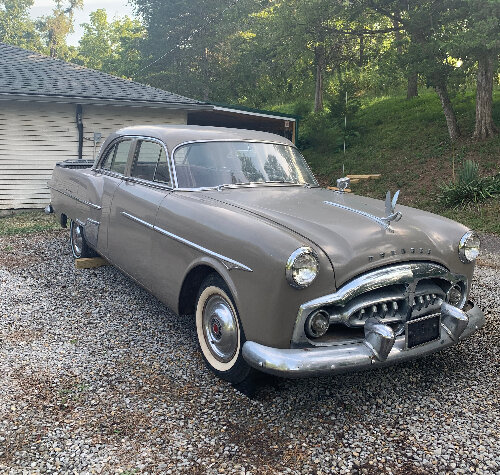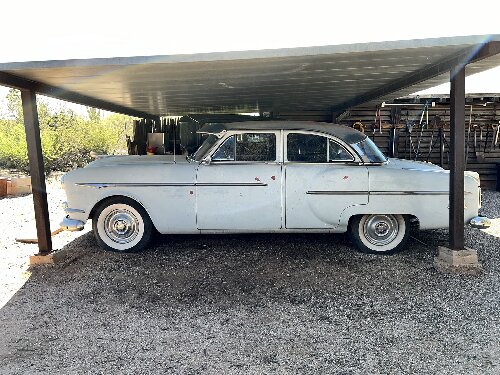|
Re: 1947 super clipper 2103
|
||||
|---|---|---|---|---|
|
Home away from home
|
Again, Jeff Adkins, Moose Obsolete Brake Parts, Penngrove (Petaluma in the North Bay) is a lifelong Packard specialist who also supplies domestic drum brake parts Auburn through Zephyr to area parts houses. Prompt turnaround. (707) 792-9985, packardguy54@sbcglobal.net
As i PM'ed you, Mike Chirco can also help you, master cyl. (520) 730-2246 packardautoparts@gmail.com Tell them Mike '47 Super Clipper, Walnut Creek, CA referred you. BTW, they have a pair of 2103 parts cars. Tucson Packard. Long established, good people, reasonable. We don't have Bugattis. This isn't complicated. A a a n d, we have Michael Grimes at Max Merritt Packard Parts, (317) 736-6233, ext. 103. Charod Marshall at Kanter Auto Parts, sales@kanter.com, (800) 526-1096, ext. 322 https://julrichpackard.com/ John Ulrich specializes in 1933-47, knowledgeable as all the above, most reasonable.
Posted on: 12/28 16:25
|
|||
|
||||
|
Re: 1941 Clipper Dash/Model
|
||||
|---|---|---|---|---|
|
Home away from home
|
HH56's encyclopedic knowledge is boundless, as with his comment about the efficacy of fresh air ducting depending on sort of heater. Thanks as always, Howard.
Posted on: 12/7 19:10
|
|||
|
||||
|
Re: Swiss Packards
|
||||
|---|---|---|---|---|
|
Home away from home
|
We like what we like, but if there were better looking custom-bodied Packards than Graber's, i never saw them.
Posted on: 12/7 19:06
|
|||
|
||||
|
Re: Advance timing??
|
||||
|---|---|---|---|---|
|
Home away from home
|
Hesitate to post, P-51, but first, it is retarded timing that makes an i.c.e. start more readily.
However, after an interesting conversation last week with Daytona Carburetor's 1974 founder/CEO Ron Hewitt, who lauds Hudson and Packard above others qualitatively, despite respecting Chrysler engineering and owning more Mopars 1930s-70s than either, suggests advancing our timing strains our engines more than running the factory suggested 6 degrees BTDC, in the case of my fellow 356 owners, even for those running higher compression. Because several longtime 356-engined Packards report happy running at 9, even 10 degrees BTDC, certainly no pinging, one of them running a 288 head for 8:1 compression over the factory's 6.85. My '47 Super, per a late 1947 Service Counselor sent to all Packard dealers in the day, suggested using one of the new 327 heads for owners wanting a trace more oomph, in my case, 7.5:1. Ron said if running okay advanced, not a hint of pinging, leave it, but in so many words, says doing so reduces engine life. Please, sports fans....Ron is hardly suggesting this will turn your engines into grenades, just reduces their optimal life expectancy. I'm begging you; read this slowly, consult a dictionary before reacting. Hesitate posting this because i o n l y....want to hear from those with solid engineering knowledge about Ron's observation of reduced engine life, not retirees and shut ins who want to see their names ever on forums.
Posted on: 12/7 18:52
|
|||
|
||||
|
Re: London Blitz
|
||||
|---|---|---|---|---|
|
Home away from home
|
Thank you, Guscha, for this powerful, moving War II history. Tho' senior Packards exported to oil-rich Canada and South America, didn't realize they were routinely sent to Britain after the advent of 1935-on juniors, but then such a huge need for large ambulances anything but routine. Thank you, sir.
Posted on: 12/4 12:44
|
|||
|
||||
|
Re: Bob Zimmerman - RIP
|
||||
|---|---|---|---|---|
|
Home away from home
|
Bob was a terrific, helpful gent, the real article. A most genuine and enthused hobbyist and steward of history.
Bob sounded young, timeless. Couldn't agree more w/ the above posters, and BlakesPackards well sums it; the hobby feeling smaller on learning the above. Losing such keepers of the flame akin to loss of the factory itself. Caramba. Godspeed Robert Zimmerman.
Posted on: 11/30 14:36
|
|||
|
||||
|
Re: 1941 120 3 Speed with Overdrive Wiring?
|
||||
|---|---|---|---|---|
|
Home away from home
|
First order of business: Clean the undercarriage so you can see what you're doing. Computer not required.
Posted on: 2023/11/27 19:06
|
|||
|
||||
|
Re: Dykes Automobile Encyclopedia
|
||||
|---|---|---|---|---|
|
Home away from home
|
Dyke's will be a real boon to anyone with an older car, Packard or not.
The Hollander Interchange Manual was another terrific resource for many of us long in this hobby. Unfortunately, the cars using the same or similar parts are now equally rare today, wrecking yards long since replaced by condos, mall and sprawl.
Posted on: 2023/11/26 17:40
|
|||
|
||||
|
Re: 1941 Clipper Badge
|
||||
|---|---|---|---|---|
|
Home away from home
|
Just an idea. Since you'll be repainting your '41 Clipper anyway? why not fill in the holes and skip the body script? The 1946-47 Custom Supers showed Packard still grasped understatement, less is more, by deleting same on the side of the body/front fender, and the 1948-50 Custom tubs omitted Packard from the trunk lid.
You've got the debut model of arguably Packard's last understated design with an international mien, free it from those nervous tics. You never saw body script on Bentleys, R-Rs, Lagondas, Delages, Hispanos, et al, and Packard through the '40s still had a refined, overbuilt chassis equal or exceeding any of them. Happy Thanksgiving.
Posted on: 2023/11/22 20:57
|
|||
|
||||








